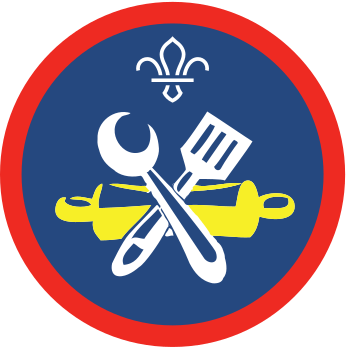Camp kitchen pitchin’
You’ll need
- Coloured pens or pencils
- Scrap paper
- Big pieces of paper
Gather ideas
- Everyone should split into small groups.
- Each group should think of different ways that camp kitchen gadgets that could help everyone keep their cooking space safe and hygienic. They should jot their ideas down on some scrap paper.
For example, a gadget could hold a wash basin or store kitchen utensils. We’ve included some more ideas under ‘Ways gadgets could help’ below.
- In the groups, everyone should work together to choose a few of their ideas and think about the gadgets that could help.
- Each group should choose their best gadget idea. An adult should help each group risk assess the use of the gadget, its construction, and its portability before they make their final choice.
Check out key documents such as guidance on camping gas, camping food safety, and carbon monoxide here.
Plan your pitch
- Now that they’ve chosen their gadget, each group should get ready to share their idea with everyone.
- Each group should plan a five-minute presentation about their gadget.
It’s up to you how people present – you can keep it informal. For example, people could pair up with someone from different groups, people could create posters to show others, or people could present sitting around a table (rather than standing in front of their audience).
- Everyone should make sure their presentations include an image of their gadget, instructions for making it, and a list of the materials and equipment people would need. Would people make their gadget before the event and bring it along, or is it something to be made once they arrive?
People could think about the ‘Questions to ask’ below to make sure their presentations cover all of the important points.
- The groups should make sure their presentation explains the health and safety benefits of their gadget. How will it keep the cooking space safe and hygienic, make sure food’s stored properly, or prevent food poisoning?
Time to present
- Each group should take it in turns to present their ideas.
- Give everyone a few minutes to think carefully about each idea. They may want to use the ‘Questions to ask’ below to help them evaluate the ideas fairly.
- Everyone should choose a few ideas to take forwards to prototype stage. They don’t need to be perfect yet – the person leading the activity may point out some things that need to change to make everything safer and more hygienic.
It’s up to you how you decide. You could score each idea against the ‘Questions to ask’ or vote with a show of hands or anonymous ballot.
- The person leading the activity should help everyone recap how the chosen gadgets help with the health and safety considerations that need to be made when setting up a campsite kitchen.
- Everyone should get into new groups, so anyone whose idea wasn’t taken forward is in a group with a gadget that’ll be made into a prototype.
- Safe storage for food
- Hand washing stations
- Utensil washing areas
- Sorting waste, recycling, and compost (so people can leave no trace)
- Food preparation zones
- Storing kitchen utensils
- Getting rid of pests and insects
- Fire safety (including water buckets and wood chopping areas)
- First aid box storage
- Displaying posters (for example about allergies, safe use of gas, food hygiene, knife safety, and fire safety)
- How well does the gadget promote camp hygiene? What does it do?
- How realistic is the idea?
- How accessible is the gadget? Could everyone in the group use it?
- How well have the group managed risk?
- Is the gadget environmentally friendly?
- Is the gadget cost effective?
Reflection
This activity was all about communication. How could people share important messages about staying safe in a camp kitchen? How did teams communicate in this activity? Was it easy to share ideas? How did people tell other groups about their ideas?
This activity was also about problem-solving. What problems did each group’s gadgets solve? Could people combine gadgets to make a complete campsite cooking space? They could use a big piece of paper to draw out where each gadget could fit in. Did people come across any problems while planning their gadgets? How did they solve them?
Safety
All activities must be safely managed. You must complete a thorough risk assessment and take appropriate steps to reduce risk. Use the safety checklist to help you plan and risk assess your activity. Always get approval for the activity, and have suitable supervision and an InTouch process.
Take it one step further by making prototypes.
Adults could step in to make suggestions that help groups refine their ideas, they could also offer a detailed breakdown of what they think makes a great campsite gadget.
No one has to present in front of everyone – groups should work together so everyone gets a chance to use their strengths. There are plenty of other, informal, ways to present.
All Scout activities should be inclusive and accessible.
Bring the ideas to life next time you’re heading on a night away and test them out. How do different camping conditions (for example, the weather, uneven ground, or needing portable equipment) change design choices?
Not only is this a great chance for people to co-design their future camping experiences, it’s an opportunity for them to build important skills in risk assessment.
